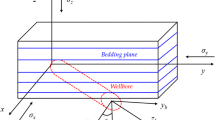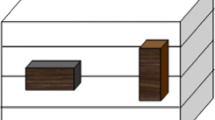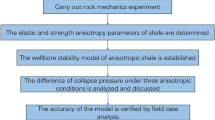Horizontal drilling is an effective way to increase the capacity of shale formations. However, in the horizontal shale drilling, the major difficulties are the problems of the wellbore stability and the well collapse prevention. In this paper, a jointed-material model is adopted to simulate the strength anisotropy and the permeability anisotropy of the bedding shale. The model is used to obtain the distribution of the plastic regions in the vicinity of the well under the condition that the stress state matches the failure criterion. The shale permeability anisotropy also contributes to the nonuniform propagation of pressure in the formation. The model is applied to study the wellbore stability law of a shale gas well in the Longmaxi formation in Sichuan Basin, China. It is shown that the drilling fluid preferably invades in the bedding plane, resulting in a higher pore pressure in the bedding plane than that in the adjusting layers. The lower strength of the bedding shale weak planes could create four plastic shear failure locations around the wellbore. This tendency is different from the normal dog-ear-shaped breakout. The study also shows that the sealing performance of the drilling fluid plays an important role in maintaining the wellbore stability. If the wellbore wall is perfectly penetrated, the increased mud weight will enlarge the plastic zone area around the well and increase the drilling risks.













Similar content being viewed by others
References
B. B. Hoxha, R. Ettehadi, J. Porter, U. Prasad, and S. H. Ong, “Improving shale wellbore integrity through membrane efficiency and geomechanics solutions,” SPE Asia Pacific Oil & Gas Conference and Exhibition, Virtual (2020).
J. C. Acevedo, “Shale membrane efficiency experimental study using water-based muds,” PhD Thesis, University of Texas (2007).
E. S. Muniz, S. A. B. Da Fontoura, R. G. Duarte, and R. T. F. Lomba, “Evaluation of the shale-drilling fluid interaction for studies of wellbore stability,” Alaska Rocks 2005, The 40th US Symposium on Rock Mechanics (USRMS), Anchorage, Alaska (2005).
W. Dye, K. Daugereau, N. Hansen, M. Otto, L. Shoults, R. Leaper, D. Clapper, and T. Xiang, “New water-based mud balances high-performance drilling and environmental compliance,” SPE/IADC Drilling Conference, Amsterdam, Netherlands (2005).
R. Schlemmer, J. E. Friedheim, F. B. Growcock, J. B. Bloys, J. A. Headley, and S. C. Polnaszek, “Chemical osmosis, shale, and drilling fluids,” SPE Drill. Complet., 18, 318-331 (2003).
X. Yan, L. You, Y. Kang, X. Li, C. Xu, and J. She, “Impact of drilling fluids on friction coefficient of brittle gas shale,” Int. J. Rock Mechan. Min. Sci., 106, 144-152 (2018).
X. Yan, Y. Kang, L. You, C. Xu, C. Lin, and J. Zhang, “Drill-in fluid loss mechanisms in brittle gas shale: a case study in the Longmaxi Formation, Sichuan Basin, China,” J. Pet. Sci. Eng., 174, 394-405 (2019).
P. Bautmans, E. Fjær, and P. Horsrud, “The effect of weakness patches on wellbore stability in anisotropic media,” Int. J. Rock Mechan. Min. Sci., 104, 165-173 (2018).
C. Cheng, X. Li, and H. Qian, “Anisotropic failure strength of shale with increasing confinement: behaviors, factors, and mechanism,” Materials, 10, 1310 (2017).
R. Gholami, B. Aadnoy, L. Y. Foon, and H. Elochukwu, “A methodology for wellbore stability analysis in anisotropic formations: a case study from the Canning Basin, Western Australia,” J. Nat. Gas Sci. Eng., 37, 341-360 (2017).
Windarto, A. Y. Gunawan, P. Sukarno, and E. Soewono, “Modelling of formation damage due to mud filtrate invasion in a radial flow system,” J. Pet. Sci. Eng., 100, 99-105 (2012).
J. Lang, S. Li, and J. Zhang, “Wellbore stability modeling and real-time surveillance for deepwater drilling to weak bedding planes and depleted reservoirs,” SPE/IADC Drilling Conference and Exhibition, Amsterdam, Netherlands (2011).
J. C. Jaeger, “Shear failure of anistropic rocks,” Geol. Mag., 97, 65-72 (1960).
T. Ramamurthy, G. Rao, J. Singh, et al., “A strength criterion for anisotropic rocks,” Fifth Australia-New Zealand Conference on Geomechanics: Prediction Versus Performance, Sydney, Australia (1988).
P. V. Lade, “Modeling failure in cross-anisotropic frictional materials,” Int. J. Solid. Struct., 44, 5146-5162 (2007).
G. Duveau, J. F. Shao, and J. P. Henry, “Assessment of some failure criteria for strongly anisotropic geomaterials,” Mech. Cohes. Frict. Mater. 3, 1-26 (1998).
A. Tohidi, A. Fahimifar, and V. Rasouli, “Analytical solution to study depletion/injection rate on induced wellbore stresses in an anisotropic stress field,” Geotech Geol Eng, 36(34-35), 1-10 (2017).
H. Lee, S. H. Ong, M. Azeemuddin, and H. Goodman, “A wellbore stability model for formations with anisotropic rock strengths,” J. Pet. Sci. Eng., 96-97, 109-119 (2012).
S. M. Ekbote, “Anisotropic poromechanics of the wellbore coupled with thermal and chemical gradients,” Dissertation, Oklahoma University (2002).
Y. Abousleiman and S. Ekbote, “Solutions for the inclined borehole in a porothermoelastic transversely isotropic medium,” J. Appl. Mech., 72, 102-114 (2005).
A. Ghassemi, Q. Tao, and A. Diek, “Influence of coupled chemo-poro-thermoelastic processes on pore pressure and stress distributions around a wellbore in swelling shale,” J. Pet. Sci. Eng., 67, 57-64 (2009).
Z. Wang and Y. Chen, “Finite element analysis of thermally induced stresses in the near-wellbore region during invasion of mud into fractures,” J. Energy Resour. Technol., 140, 052909 (2018).
X. Zhou and A. Ghassemi, “Finite element analysis of coupled chemo-poro-thermo-mechanical effects around a wellbore in swelling shale,” Int. J. Rock Mechan. Min. Sci., 46, 769-778 (2009).
W. Cao, J. Deng, W. Liu, B. Yu, Q. Tan, L. Yang, Y. Li, and J. Gao, “Pore pressure and stress distribution analysis around an inclined wellbore in a transversely isotropic formation based on the fully coupled chemo-thermo-poroelastic theory,” J. Nat. Gas Sci. Eng., 40, 24-37 (2017).
Acknowledgements
The authors acknowledge the financial support of the National Natural Science Foundation of China (No.51904037) and the General Project of Natural Science Research in Colleges and Universities of the Jiangsu Province (19KJD440001).
Author information
Authors and Affiliations
Corresponding author
Additional information
Translated from Khimiya i Tekhnologiya Topliv i Masel, No. 1, pp. 202–209 January – February, 2022.
Rights and permissions
About this article
Cite this article
Wenke, C., Wei, L. The Wellbore Stability Study in Bedding Shale Formationon the Condition of Plasticity. Chem Technol Fuels Oils 58, 220–231 (2022). https://doi.org/10.1007/s10553-022-01370-y
Published:
Issue Date:
DOI: https://doi.org/10.1007/s10553-022-01370-y




